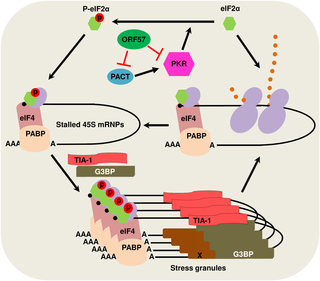PLoS Pathogens ( IF 5.5 ) Pub Date : 2017-10-30 , DOI: 10.1371/journal.ppat.1006677 Nishi R. Sharma , Vladimir Majerciak , Michael J. Kruhlak , Zhi-Ming Zheng

|
TIA-1 positive stress granules (SG) represent the storage sites of stalled mRNAs and are often associated with the cellular antiviral response. In this report, we provide evidence that Kaposi’s sarcoma-associated herpesvirus (KSHV) overcomes the host antiviral response by inhibition of SG formation via a viral lytic protein ORF57. By immunofluorescence analysis, we found that B lymphocytes with KSHV lytic infection are refractory to SG induction. KSHV ORF57, an essential post-transcriptional regulator of viral gene expression and the production of new viral progeny, inhibits SG formation induced experimentally by arsenite and poly I:C, but not by heat stress. KSHV ORF37 (vSOX) bearing intrinsic endoribonuclease activity also inhibits arsenite-induced SG formation, but KSHV RTA, vIRF-2, ORF45, ORF59 and LANA exert no such function. ORF57 binds both PKR-activating protein (PACT) and protein kinase R (PKR) through their RNA-binding motifs and prevents PACT-PKR interaction in the PKR pathway which inhibits KSHV production. Consistently, knocking down PKR expression significantly promotes KSHV virion production. ORF57 interacts with PKR to inhibit PKR binding dsRNA and its autophosphorylation, leading to inhibition of eIF2α phosphorylation and SG formation. Homologous protein HSV-1 ICP27, but not EBV EB2, resembles KSHV ORF57 in the ability to block the PKR/eIF2α/SG pathway. In addition, KSHV ORF57 inhibits poly I:C-induced TLR3 phosphorylation. Altogether, our data provide the first evidence that KSHV ORF57 plays a role in modulating PKR/eIF2α/SG axis and enhances virus production during virus lytic infection.
中文翻译:

KSHV通过阻断PKR激活的病毒ORF57抑制应激颗粒的形成
TIA-1正应力颗粒(SG)代表停滞的mRNA的存储位点,通常与细胞抗病毒反应有关。在本报告中,我们提供了证据,证明卡波西氏肉瘤相关疱疹病毒(KSHV)通过抑制SG经由病毒裂解蛋白ORF57的形成而克服了宿主的抗病毒反应。通过免疫荧光分析,我们发现具有KSHV裂解感染的B淋巴细胞对SG诱导是难治的。KSHV ORF57是病毒基因表达和新病毒后代产生的必需转录后调节剂,可抑制由砷和多聚I:C(但不受热应激)实验性诱导的SG形成。带有固有核糖核酸内切酶活性的KSHV ORF37(vSOX)也抑制了亚砷酸盐诱导的SG的形成,但KSHV RTA,vIRF-2,ORF45,ORF59和LANA没有这种功能。ORF57通过其RNA结合基序与PKR激活蛋白(PACT)和蛋白激酶R(PKR)结合,并阻止PKR途径中抑制KSHV产生的PACT-PKR相互作用。一致地,敲低PKR表达可显着促进KSHV病毒粒子的产生。ORF57与PKR相互作用以抑制PKR结合dsRNA及其自身磷酸化,从而导致eIF2α磷酸化和SG形成受到抑制。同源蛋白HSV-1 ICP27,而不是EBV EB2,在阻断PKR /eIF2α/ SG途径的能力上类似于KSHV ORF57。此外,KSHV ORF57抑制聚I:C诱导的TLR3磷酸化。总而言之,我们的数据提供了第一个证据,表明KSHV ORF57在调节PKR /eIF2α/ SG轴中起作用,并在病毒裂解感染过程中增强病毒的产生。











































 京公网安备 11010802027423号
京公网安备 11010802027423号